Ask a question from expert
Legal and Ethical Parameter to Nursing Practice
21 Pages6251 Words372 Views
Added on 2020-06-04
Legal and Ethical Parameter to Nursing Practice
Added on 2020-06-04
BookmarkShareRelated Documents
LEGAL AND ETHICALPARAMETER TONURSING PRACTICE

Table of Contents1. Legal and ethical considerations of nursing profession which are implemented in nursingpractice of Australia....................................................................................................................32. The following pieces of legislation and regulation impact nursing practice........................123. Legislation impact on nursing practice: ...............................................................................134. Two professional aspects breached by Nurse in given scenario...........................................145. Scenario.................................................................................................................................146.Scenario..................................................................................................................................147. 2 legal requirements which are applied when writing nursing reports. ...............................148. Abusing Patient.....................................................................................................................149. Involvement of health care staff............................................................................................1510. Ethics...................................................................................................................................1511. Law......................................................................................................................................1512. Application of National Safety and Quality Health Service (NSQHS) Standards..............1713. The role of Nursing and Midwifery Board of Australia. ...................................................1714. Theoretical concepts...........................................................................................................1715. Various clinical situations will leave you in an ethical dilemma........................................1717. 2 sources to accessing information of Australian legislation..............................................1818. 2 requirements of obtaining a valid consent. .....................................................................1819. Difference between implied consent and expressed consent..............................................1920. Functions of the coroner in relation to a healthcare event..................................................1921. Evidence required for corner...............................................................................................1922. Civil penalty under Privacy act...........................................................................................19REFERENCES..............................................................................................................................20
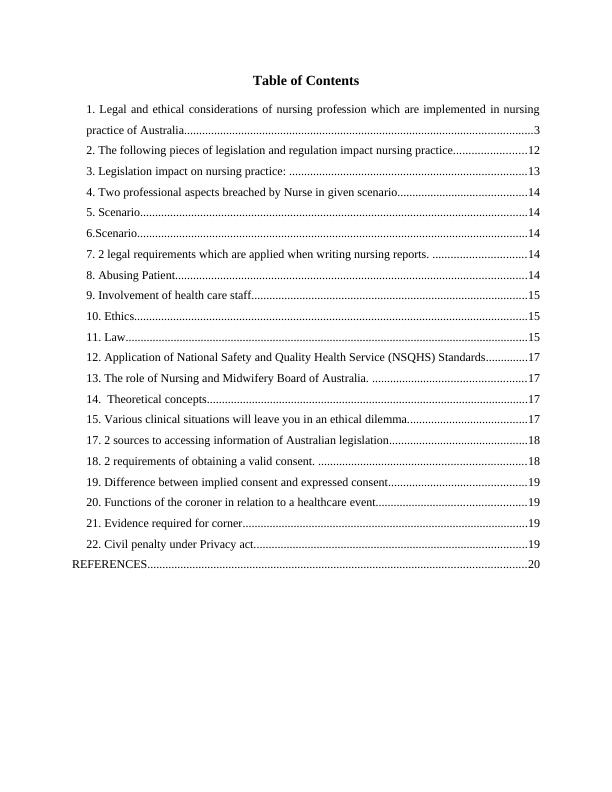
1. Legal and ethical considerations of nursing profession which are implemented in nursingpractice of Australia.a) Children in the workplaceIn Australian the Legal framework of regarding Nurses at eat care centre is focused onbehaviour of nurses with children at workplace. The ethics states that no nurse is allowed tobehave impulsively with children in case of vulnerability (Stuart 2014). Nurses are liable to treatchildren with patience. The ethics and legal practices of Nurses in Australia are developed toserve quality nursing experience to children at health care centre. b) Code of Ethics for Nurses in Australia (Nursing and Midwifery Board of AustraliaCode of Ethics for Nurses in Australia are enabled by the government to set ethical andlegal standard for nurses to deal patients at health care centre. Further, the code of ethics formidwives are set by midwifery board of Australia to deliver relevant maternity services in whichthe nurses are trained to understand the diversity of people (James, Nelson and Ashwill 2014).Moreover, that Midwives should serve quality services and care to woman and her new bornchild. Thus, it also emphasizes on behaviours in which nurses are liable to behave and treat selfand other individual with respect and kindness. c)Code of Professional Conduct for Nurses (Nursing and Midwifery Board of AustraliaProfessional code of Conduct set by Australian Nursing Board are as follows:Nurses should be working under healthy and safe working condition.Nurses should practice all standards ofProfession formulated and implemented by Australian health system.Nurses should practice their work under legal framework set by Australian government. Nurses should understand the responsibility of professional standards which aims atenhancing safety of patients at health care centre (Johnstone 2015.).d) Codes of practice
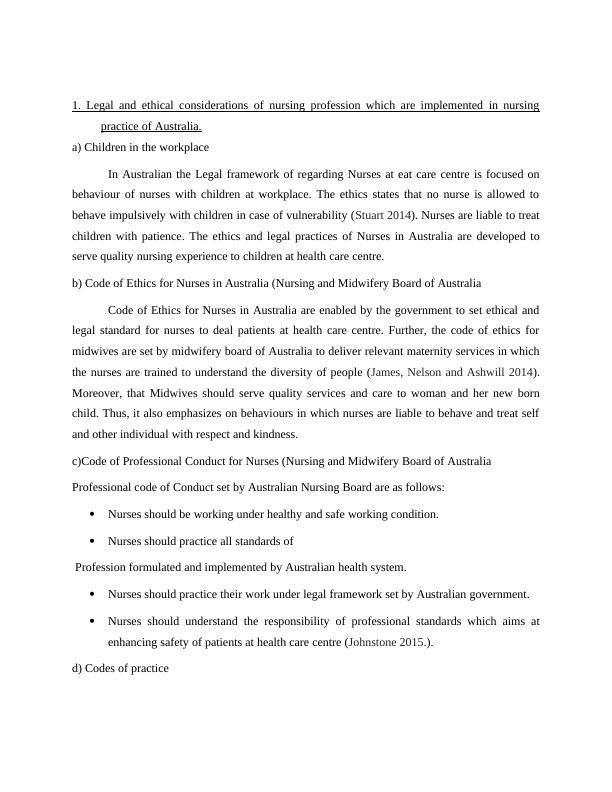
Australian board of Health system has developed code of practice which are necessaryfor nurses to implement in their professional life at health care centre which states Nurses need topractice basic health care codes such as:Delivering quality services to individual at health care centre. To treat individual with respect and kindness.Instant decision making (Furrow and et.al., 2014).Ethical management of confidential information. Nurses are liable to promote and maintain sustainability of health care centre. e) Continuing professional education opportunities and mandatory CPD requirements for nursesThe Australian board has clearly determined and defined continuing professionaldevelopment plan in which it has some set of rules and regulation which are mandatory fornurses to follow like, 20 hours of working for registered nurses.20 hours of working for enrolled nurses which is divided into 2 shifts. 20 hours of working for registered midwives.20 hours for practising nurses excluding 10 hours of endorsement. Besides, in this health care centre provides education information and training to Nursesin order to enhance their level of understanding (O'byrne, Holmes and Roy 2015).f) Direct and indirect discrimination and its implications.Discrimination has become the part of system which is increasing biasness andinequalities in the country. Further there are two types of discrimination faced by Nurses atAustralian Health care centres which are as follows:Direct discrimination in Healthcare centre can be when the nurses are being treatedunequally by management in terms of time work or anything. Indirect discrimination is when the nurses are asked to work overtime without any pay orwork. It can be done in many ways like, by scolding and insulting in front of colleagues orpatients (Norman and Ryrie, 2013).
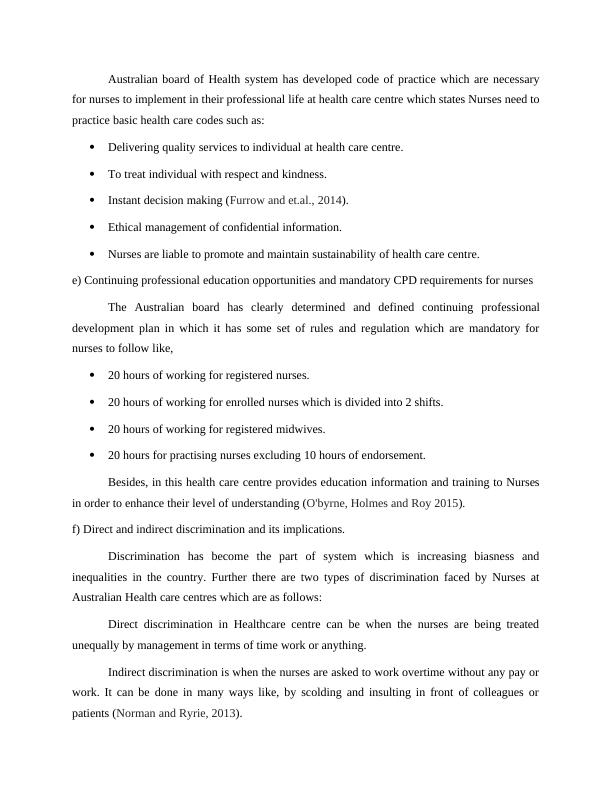
Therefore, to avoid such practices the Australian board has defined set of rules, ethics andpractices which decrease the chances of discrimination. The board has policies and procedures inwhich there is clear set of procedure of work and time for every type of Nurse which reduces thechance of developing inequalities. g) Duty of care of an enrolled nurseIt is the duty of Nurses to follow duty of care which are formulated to protect the right ofindividual at heath care centre. The Australian Board has clearly defined duties for enrollednurses which are described under:Nurses are trained to quickly respond to the situation.Nurses are liable to respond to colleagues in case of any emergency. Nurses should always be present wit the patient (Fortinash and Worret 2014).Most importantly the nurses are liable to improve their quality of delivering service untildeath.Respond with kindness and respect.Nurses should maintain calm and harmony within the health care centre.Nurses should understand the criteria of reducing isolation, fear and anxiety fromindividuals mind. H) Equal employment opportunity (EEO) Equal Employment Opportunity (EEO) are established by Australian board at health carecentre to make environment free from discrimination, harassment and inconsideration ofproviding job opportunities which are available for every skilled and capable nurses regardless ofsexual preference, disability, gender, age, race, marital or parental status and religion. Beside, theorganisations are also liable to comply with the regulations enforced by government of U.S.Which is Equal Employment Opportunity Commission (EEOC).I) Human rights including access to healthcare
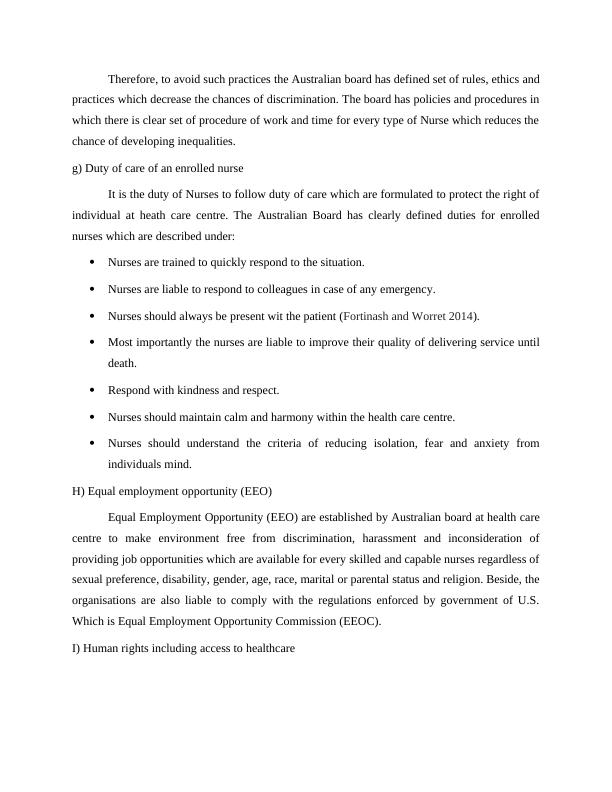
Human rights are related to each other in context to freedom and rights and are equal forall the citizens of the country. The humans which are implemented at Australian health carecentre to support and protect the rights of individuals which are described under:Nurses are provided safe and environment to work in which the individuals are liable tospeak for their rights and allowed to enjoy liberty and life keeping the environment ofhealth care (Weiss and Tappen 2014.).Provided access to quality food and water and shelter.j) Informed consent It plays a vital role as it is the core duty of nurses to maintain the procedure of informedconsent which is maintaining appropriate record and documents of patient under definedprocedure of health care centre. Further, informed consent assist Nurses in keeping a record ofall health care facilities and amenities (Hood 2013.). Thus, most important it is the core duty ofnurses to keep patients and its family informed about all the procedure and medication regardingthe health of individual in which the Nurses are liable to take sign of people handling patient butthe individual should be of at least 18 years. k) Professional indemnity insurance arrangements for enrolled nursesThe Nursing and Midwifery Board of Australia (NMBA) enacts the rules set by theHealth Practitioner Regulation National Law. Further, NMBA regulates the practice and ethicsof midwives and nurses in health care centre. Te ultimate motive of enacting this is to protect therights of individual at hospitals. The NMBA keeps developing standards, guidelines and code ofethics which are mandatory to be followed by Midwives and nurses. Moreover, section 129 ofthe National Law, in which nurses must not practise the profession in which the individuals arenot registered unless appropriate professional indemnity insurance (PII) arrangements are inforce in relation to ethics and services. This section is enforced to reduce the risk of decline inquality of services in health care centres. l) Public liability insurance arrangements for enrolled nurses.Australian board has set some rule to protect the right of individual to whom nurses andleoutside hospital which are as follows:
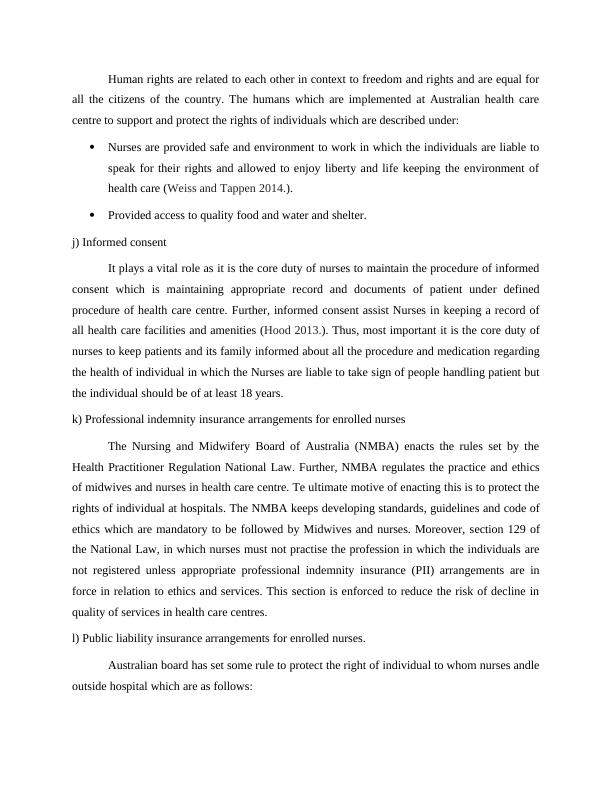
End of preview
Want to access all the pages? Upload your documents or become a member.
Related Documents
Nursing Care Case Study NMBAlg...
|8
|2436
|66
Professional Practice Model - Nursinglg...
|5
|913
|15
Professional Nursing Planning | Australian Nursing Industrylg...
|6
|1393
|19
Nursing Assignment - code of ethics for nurseslg...
|25
|8012
|404
Health Practitioners Regulation National Lawlg...
|10
|3449
|24
Professional Practice in Nursing | Reportlg...
|6
|974
|13